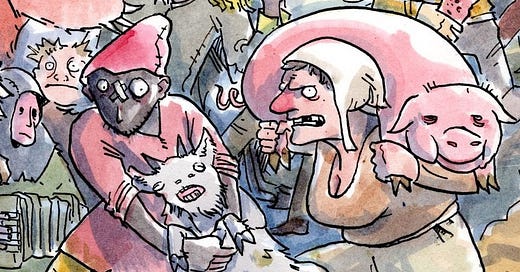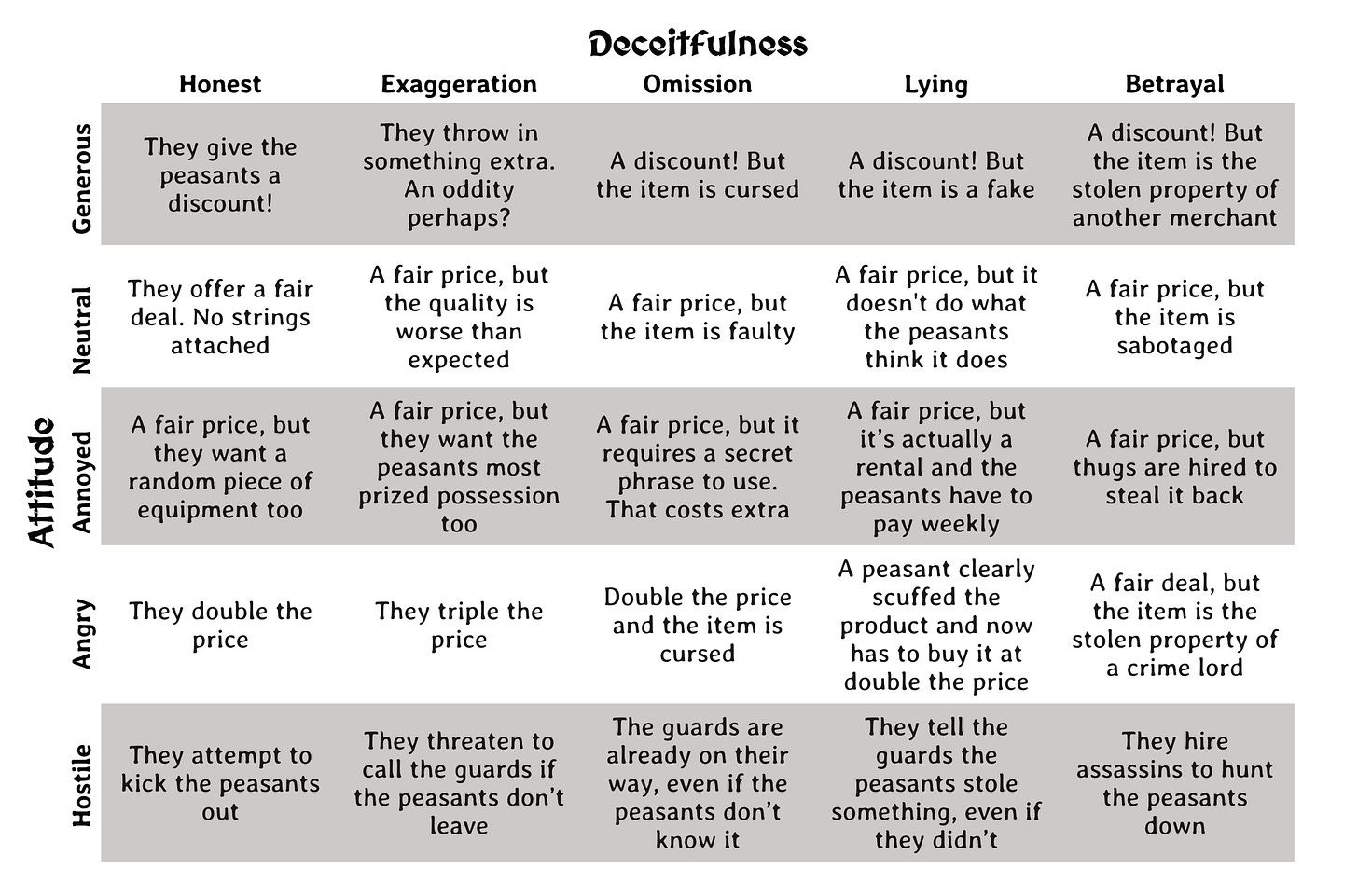Note: This tracking system was originally designed for my game Peasantry, but it is easily adapted for use in many other TTRPGs.
Hello Peasants!
I recently had the inspiration to design a fairly simple system for tracking the attitude, deceitfulness, and patience of a sleazy merchant. All these factors come into play to inform the GM as to what kinds of offers the merchant will present to the filthy peasants who are mucking up their store. Will the merchant sell the peasants a cursed item? Stolen? Maybe they will send thugs to steal it back from them? Who knows! This system is designed for those that enjoy the roleplay aspects of haggling but want a bit more depth and direction.
The Bartering System
The core aspect of this system is the following table. This table tracks the attitude and deceitfulness of the merchant. By cross-referencing these two traits we can find the type of deal being offered to the peasants throughout negotiations. The system is designed to work seamlessly with roleplay; it is really just a way for the GM to track the merchant’s mood while portraying the character. Players generally won’t know what is on the table, nor where they are, but it might be good to share how much patience the merchant has left.
Use the following four steps to see how to use the table.
Step 1: Attitude & Deceit
Before we can begin the bartering process, we must first find the Merchants initial attitude and deceitfulness towards the peasants. Answer these two questions to determine your starting location on the table:
Who is the normal customer?
The Rich: start at angry
Middle Class: start at annoyed
The Poor: start at neutral
Where is the shop located?
Black Market: start at lying
Edge of Town: start at omission
Town Square: start at exaggeration
Step 2: Patience
Next, we have to determine how much patience the merchant has for a group of filthy peasants. Answer the following question and place a d6 on the starting location with the patience value face up on the die.
Have they met before?
Yes, it went badly: 2 Patience
No, first meeting: 4 Patience
Yes, it went well: 6 Patience
Step 3: Bartering
Alright, here is the meat and bones of the system. The GM and peasants will roleplay and take action as normal within the game. Whenever the peasants do or say something that will affect the merchant’s mood, the GM will shift the die along the table accordingly. A check is not required to shift the die, in fact, I highly encourage moving the die strictly based on the roleplay of the peasants. For every square shifted, lose 1 patience on the die. Diagonal moves are allowed.
When the peasants are out of patience, no more progress can be made towards an Honest & Generous deal.
Here are some general guidelines for how and when to move the die:
Successful Check: shift towards Generous & Honest
Failed Check: shift towards Hostile & Betrayal
Trick: shift towards generous
Low Ball: shift towards hostile
Threaten: shift toward betrayal
Question: shift toward honest
Rude: shift toward hostile
Kind: shift toward generous
Gifts: increase patience by 1
Loiter: decrease patience by 1
Stealing/Attacking: shift all the way to hostile, any farther actions cause a shift towards betrayal. All patience is lost.
Step 4: The Deal
At any point in the process, the peasants can accept the deal being offered. The location of the die informs the GM as to what kind of deal is being offered. The exact details (payments, goods, promises, quests, etc.) of the deal is entirely up to the GM’s discretion.
Conclusion
While not all GM’s may find this tracking tool useful, for those who want a little bit more structure to their bartering and haggling, this tracking system will help guide you. The current table is designed for peasants to haggle with sleazy merchants, but it should be easy enough to modify the deals and attitudes to fit more other types of merchants or characters.
Do you think it be useful for you? What might you change? Are there any situations that would throw it all off? Let me know what you think of this bartering tracker!






